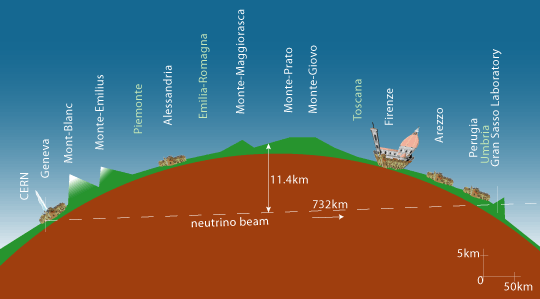Musings on Faster-than-Light Neutrinos
September 30, 2011
NOTE: This article is out of date. Not too long after I wrote it, the scientists discovered their error, so there were no FTL neutrinos, but I’ve left the article here for amusement anyway.
I am not a theoretical physicist! I can do Newtonian physics in my sleep and I’ve read one book by Einstein, but when it comes to quantum mechanics, string theory, and the rest, my knowledge is sketchy at best.
Recently, scientists at CERN near Geneva Switzerland, and the Gran Sasso National Laboratory in Italy, appear to have clocked some neutrinos (small, nearly massless, sub-atomic particles) travelling marginally faster than the speed of light. To their credit, they freely admit that perhaps they have made an error, and physicists from around the world are trying to help them find it. After all, what they’ve found violates the laws of the universe as we “know” them (for now).
But what if there is no error? What if these particles really were travelling at faster-than-light speeds? According to Einstein’s Theory of Relativity (which although only a theory, has fit all observations until now), nothing with mass can accelerate to the speed of light without using an infinite amount of energy to do so. But physicists have postulated the existence of a class of particles, collectively known as tachyons, that always travel at or faster than the speed of light. The “always” is the key: these particles didn’t need to accelerate to their superluminal speeds; they’ve always been moving that fast and always will be.
According to the measurements, the recently clocked neutrinos traveled at 1.00002 times the speed of light over a distance of 730km through solid rock (neutrinos aren’t affected much by matter in their path). On the other hand, the neutrinos from a supernova that occurred about 160,000 years ago, and was observed on Earth in 1987, arrived only three hours ahead of the light instead of the three or four years suggested by the speed of the experimental neutrinos. Furthermore that time difference was attributed to the light being slowed down by the gases around the exploding star (light travels more slowly in a medium than in it does in empty space). This would seem like solid evidence that the results of the recent experiment are in error, and has repeatedly been given as the counter-example in the last few days.
But what if neutrinos are a variety of tachyon? What if they always travel at the speed of light or higher? Perhaps the speed of light is the lower speed limit for a neutrino, the speed they travel in a vacuum. Maybe travelling through a medium causes them to move faster: the denser the medium, the faster they go. This idea is consistent with (but certainly not proven by) the observations:
- The neutrinos from the 1987 supernova traveled through vacuum for 160,000 years at exactly the speed of light, with no intervening matter to speed them up, and arrived at about the same time as the light.
- The neutrinos in the recent experiment traveled through solid rock for 3 milliseconds, and arrived a little earlier than ought to be possible.
The question then is: why would they travel faster through matter than through vacuum?
Maybe they didn’t, but instead took a shortcut in another dimension. The presence of matter bends space and time, which could conceivably shorten the distance between two points when measured in a higher spatial dimension. If the neutrinos simply travel along the path of least resistance, perhaps they’d naturally take that shortcut. The neutrinos traveling from the supernova to Earth had no shorter route, so they took about as long as the light did to get here. The neutrinos traveling through solid rock on the other hand did have the benefit of slightly bent space-time, and thus a (very) slight shortcut.
This is, of course, purely conjecture. It would have to be verified by experiment, perhaps by beaming neutrinos through either a denser material, or just through much longer distances in ordinary rock. For example, if they were sent straight through the Earth, they should take about 43ms instead of only 3ms to reach the other side. If they traveled at 1.00002 times light speed, they should arrive about 900ns early, a time measurement that is much less likely to be in error.
Finally, if it does turn out to be true, is it of any use? Probably not. Wouldn’t it be ironic if we could harness neutrinos to achieve a method of faster than light travel … that doesn’t work in space.
Further Reading
- Faster Than Light Neutrinos? Not So Fast, io9.com, 2011-Sep-22
- Faster-Than-Light Neutrinos? Physics Luminaries Voice Doubts, Scientific American, 2011-Sep-26
- Faster-than-light neutrinos could be proof of extra dimensions, io9.com, 2011-Sep-28

If you've found this article useful, consider leaving a donation in Stefan's memory to help support stefanv.com
Disclaimer: Although every effort has been made to ensure accuracy and reliability, the information on this web page is presented without warranty of any kind, and Stefan Vorkoetter assumes no liability for direct or consequential damages caused by its use. It is up to you, the reader, to determine the suitability of, and assume responsibility for, the use of this information. Links to Amazon.com merchandise are provided in association with Amazon.com. Links to eBay searches are provided in association with the eBay partner network.
Copyright: All materials on this web site, including the text, images, and mark-up, are Copyright © 2026 by Stefan Vorkoetter unless otherwise noted. All rights reserved. Unauthorized duplication prohibited. You may link to this site or pages within it, but you may not link directly to images on this site, and you may not copy any material from this site to another web site or other publication without express written permission. You may make copies for your own personal use.

